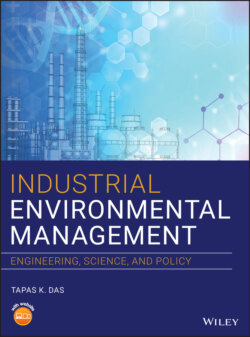Читать книгу Industrial Environmental Management - Tapas K. Das - Страница 21
1.4 Defining Pollution Prevention
ОглавлениеIn this book, we define pollution prevention fairly broadly as any action that prevents the release of harmful materials to the environment. This definition manifests itself in the form of a pollution prevention hierarchy, with safe disposal forms at the base of the pyramid and minimizing the generation of waste at the source at the peak (Figure 1.1).
Figure 1.1 Pollution prevention hierarchy.
In contrast, the U.S. Environmental Protection Agency (USEPA) (1992) definition of pollution prevention recognizes only source reduction and conservation, which encompasses only the upper two tiers in the hierarchy – minimize generation and minimize introduction. The USEPA describes the seven‐level hierarchy of Figure 1.1 as “environment management options.” The European Community, on the other hand, includes the entire hierarchy in its definition of pollution prevention. The tiers in the pollution prevention hierarchy are broadly described as follows.
Minimize generation: Reduce to a minimum the formation of nonsalable by‐products in chemical reaction steps and waste constituents (such as tars, fines, etc.) in all chemical and physical separation steps.
Minimize introduction: Cut down as much as possible on the amounts of process materials that pass through the system unreacted or are transformed to make waste. This implies minimizing the introduction of materials that are not essential ingredients in making the final product. For examples, plant designers can decide not to use water as a solvent when one of the reactants, intermediates, or products could serve the same function, or they can add air as an oxygen source, heat sink, diluent, or conveying gas instead of large volumes of nitrogen.
Segregate and reuse: Avoid combining waste streams together with no consideration to the impact on toxicity or the cost of treatment. It may make sense to segregate a low‐volume, high‐toxicity wastewater stream from high‐volume, low‐toxicity wastewater streams. Examine each waste stream at the source and identify any that might be reused in the process or transformed or reclassified as valuable coproducts.
Recycle: Many manufacturing facilities, especially chemical plants, have internal recycle streams that are considered part of the process. In addition, however, it is necessary to recycle externally such materials as polyester film and bottles, Tyvek envelopes, paper, and spent solvents.
Recover energy value in waste: As a last resort, spent organic liquids, gaseous streams containing volatile organic compounds (VOCs), and hydrogen gas can be burned for their fuel value. Often the value of energy and resources required to make the original compounds is much greater than that which can be recovered by burning the waste streams for their fuel value (also see Appendix G).
Treat for discharge: Before any waste stream is discharged to the environment, measures should be taken to lower its toxicity, turbidity, global warming potential, pathogen content, and so on. Examples include, but not limited to, biological wastewater treatment, carbon adsorption, filtration, and chemical oxidation.
Safe disposal: Render waste streams completely harmless so that they do not adversely impact the environment. In this book, we define this as total conversion of waste constituents to carbon dioxide, water, and nontoxic minerals. An example would be posttreatment of a wastewater treatment plant effluent in a private wetland. So‐called secure landfills do not fall within this category unless the waste is totally encapsulated in granite.
